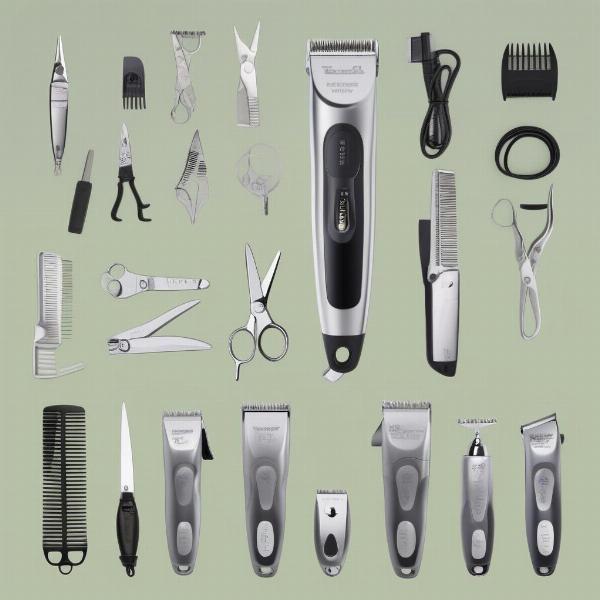Dog clippers are essential tools for maintaining your dog’s coat health and appearance. Whether you’re a seasoned groomer or a first-time pet owner, understanding how to choose and use dog clippers can make a significant difference in your dog’s comfort and well-being. This guide covers everything you need to know about dog clippers, from selecting the right type to mastering clipping techniques.
Choosing the Right Dog Clipper
The market offers a wide variety of dog clippers, each designed for specific coat types and grooming needs. Consider your dog’s breed, coat length and thickness, and your own grooming experience when making a selection. Key factors include:
- Blade Type: Different blade types offer varying cutting lengths and are suited for different coat textures. Ceramic blades stay cooler, reducing the risk of burns, while stainless steel blades are durable and easy to sharpen.
- Motor Power: Powerful motors are essential for thick or matted coats, while quieter motors are ideal for nervous dogs. Choose a clipper with adjustable speed settings for greater control.
- Corded vs. Cordless: Corded clippers provide consistent power, while cordless clippers offer greater maneuverability. Consider your grooming space and the length of your grooming sessions.
- Noise Level: Noise-sensitive dogs may benefit from clippers designed for quiet operation. Look for clippers with noise-reduction technology.
- Ergonomics: A comfortable grip and lightweight design will reduce hand fatigue during longer grooming sessions.
 Choosing the right dog clipper for your dog's coat
Choosing the right dog clipper for your dog's coat
Preparing Your Dog for Clipping
Before you begin clipping, it’s crucial to prepare your dog both physically and mentally. A positive and relaxed experience will make future grooming sessions much easier.
- Bathing and Drying: A clean, dry coat is essential for effective clipping. Bathe your dog a day or two before clipping to allow the coat to dry completely.
- Brushing: Thoroughly brush your dog’s coat to remove any tangles or mats. This will prevent the clippers from pulling and causing discomfort.
- Desensitization: Introduce your dog to the clippers gradually. Let them sniff and hear the clippers running before attempting to clip their coat. Reward calm behavior with treats and praise.
Clipping Techniques and Tips
[dog clipper with vacuum]
Proper clipping techniques are essential for achieving a smooth and even cut while keeping your dog comfortable.
- Direction of Growth: Always clip in the direction of hair growth to avoid irritation and ingrown hairs.
- Short Strokes: Use short, overlapping strokes to ensure an even cut and prevent clipper lines.
- Cooling Breaks: Take frequent breaks to allow the clipper blades to cool down, especially when working with thick coats.
- Difficult Areas: Use caution around sensitive areas such as the face, ears, and paws. Use a smaller clipper or scissors for these areas.
Maintaining Your Dog Clippers
Proper maintenance will extend the lifespan of your clippers and ensure optimal performance.
- Cleaning: Clean the blades after each use with a clipper brush and disinfectant spray.
- Oiling: Regularly oil the blades to prevent friction and overheating.
- Sharpening: Sharpen the blades as needed to maintain a sharp cutting edge.
Troubleshooting Common Clipping Problems
- Clipper Burn: This occurs when the clipper blades overheat and burn the skin. Prevent clipper burn by using cool blades, taking frequent breaks, and using clipper coolant.
- Uneven Cuts: Uneven cuts can be caused by dull blades, improper clipping techniques, or an uneven coat. Ensure your blades are sharp and practice proper clipping techniques.
- Dog Anxiety: If your dog is anxious during clipping, try desensitization techniques, positive reinforcement, and a calming environment.
[wahl century dog clipper]
Conclusion
[wahl dog clippers km2]
Mastering the art of dog clipping requires patience, practice, and the right tools. By understanding your dog’s individual needs, selecting the appropriate dog clippers, and following proper clipping techniques, you can maintain your dog’s coat health, enhance their appearance, and strengthen your bond.
FAQ
- How often should I clip my dog’s coat? This depends on your dog’s breed and coat type. Some breeds require regular clipping every few weeks, while others only need occasional trims.
- Can I use human clippers on my dog? It’s not recommended to use human clippers on dogs. Dog clippers are specifically designed for thicker and coarser dog hair.
- What should I do if my dog’s coat is matted? If your dog’s coat is severely matted, it’s best to consult a professional groomer.
- How can I prevent clipper burn? Use cool blades, take frequent breaks, and apply clipper coolant.
- What type of clipper blade is best for my dog’s breed? Consult a professional groomer or your veterinarian for recommendations based on your dog’s breed and coat type.
- How do I sharpen my dog clipper blades? You can use a professional sharpening service or purchase a blade sharpening kit.
- What is the best way to clean my dog clippers? Use a clipper brush and disinfectant spray after each use.
[mini dog clippers]
About ILM Dog: ILM Dog is your go-to resource for expert advice on all aspects of dog care, from breed selection to health, training, nutrition, grooming, and much more. We offer practical tips and insights to help you provide the best possible care for your canine companion. We cover a wide range of topics including breed selection, health and medical care, training and behavior, nutrition and feeding, grooming and hygiene, as well as product recommendations. For inquiries regarding our services, or if you are looking for personalized advice, contact us via email at [email protected] or phone at +44 20-3965-8624.